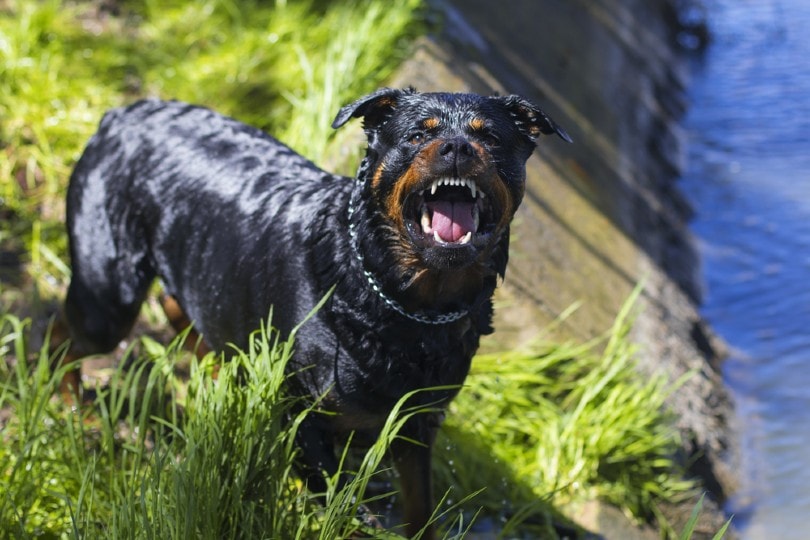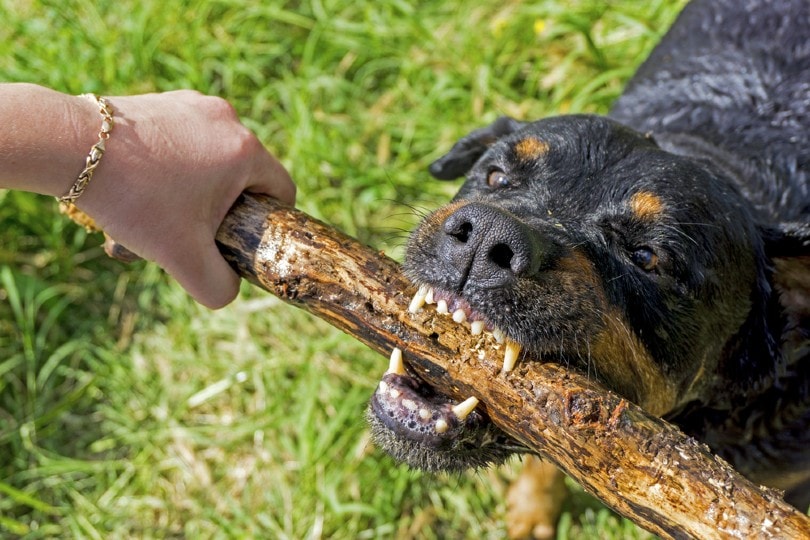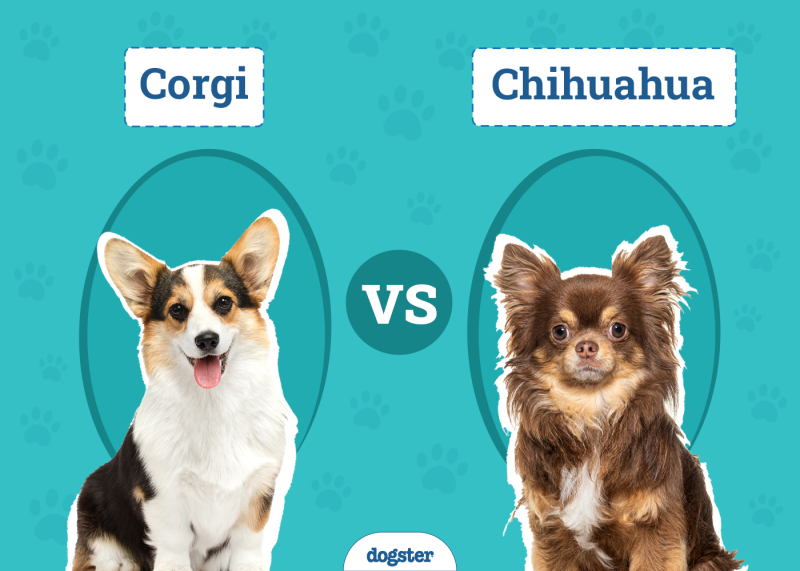Rottweilers are large and powerful dogs that are known for their protective instincts. Though they’ve been unfairly demonized as dangerous dogs, Rottweilers are loving family pets and intelligent dogs that are easy to train.
As a guard dog, the Rottweiler certainly has its merits. The Rottweiler’s bite force is nothing to mess around with at roughly 328 pounds per square inch (PSI), which is above average for a dog. Let’s examine how experts measure bite force and put the Rottweiler’s bite force in perspective.
Rottweiler Bite Force
To offer some perspective, a human’s bite force is 162 PSI on average.
- Nile crocodile: 5,000 PSI
- Saltwater crocodile: 3,700 PSI
- American alligator: 2,125 PSI
- Hippopotamus: 1,800 PSI
- Jaguar: 1,500 PSI
- Bull shark: 1,350 PSI
- Gorilla: 1,300 PSI
- Polar bear: 1,200 PSI
- Grizzly bear: 1,160 PSI
- Hyena: 1,100 PSI
As you can see, the Rottweiler doesn’t compare to some of nature’s most fearsome predators, like the crocodile, shark, or bear. It’s still over double that of the human bite force, however, and comes with sharp teeth!
How Is Bite Force Measured?
Historically, bite force has been measured using both pounds (newtons) and PSI (pounds per square inch). Both the tool and the method of measurement can produce different results.

Newtons
One newton is equal to about 0.22 pounds of bite force. If a Rottweiler’s bite force was measured and scored 2,000 newtons, that would mean a 450-pound bite force in PSI.
PSI
PSI as a measurement considers how much force a bit exerts on a specific area of the testing surface. In the case of the Rottweiler, a researcher named Dr. Barr measured the bite force by wearing a device on his sleeve and allowing the dog to bite his arm, leading to the measurement of 328 PSI.
This is a big difference from the Newton measurement, but it’s the more accurate of the two.
The discrepancy between these measurements also illustrates the problem of getting an accurate bite force for many animals. We might expect that the killer whale or great white shark would have a stronger bite force than the crocodile or jaguar, just based on sheer size, but we’ve never been able to get a true measurement. Current estimates for bite force are extrapolated from limited data.
Other Considerations with Bite Force
Much of the research into bite force has been done in an unnatural way, which may affect the results. For example, the original 2,000 newtons of bite force for the Rottweiler was gathered using sedated dogs that had their jaws electronically activated. This isn’t natural and may have impacted the results.
Researchers also measure canine jaw strength at different spots in the jaw. A dog’s bite strength would be stronger if it comes from the back of the jaw versus the front of the jaw. Furthermore, researchers also calculate bite force according to the shape and size of the animals’ heads, which can affect the results.
Do All Rottweilers Have the Same Bite Force?
The 328 PSI bite force of the Rottweiler is an average, meaning that not all Rottweilers will have the exact same measurement. Rottweilers can vary in size and strength.
According to the American Kennel Club, the formal breed standard for the adult Rottweiler falls between 80 pounds and 135 pounds. That’s a big difference in size and strength, which will translate to a big difference in bite force.
The Rottweiler also has both American and German breed lines, which widen the variations between the breed standards further. Some Rottweiler lines have larger heads and wider jaws, which may impact bite force.

Conclusion
Based on all the research done on the Rottweiler bite force, it’s likely close to the average of 328 PSI. Combined with its size and strength, this can mean a significant bite, but doesn’t mean that the dog is naturally aggressive.
Rottweilers are intelligent, loving, and easy-to-train dogs, so diligent positive reinforcement training can help you manage the breed’s natural protective instinct.
Related read:
- How Strong Is a Doberman’s Bite Force? (PSI Measure & Facts)
- How Strong is a Golden Retriever’s Bite? Measured in PSI
Featured Image Credit: Elzloy, Shutterstock



















